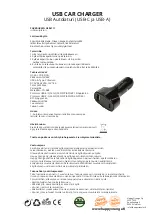
Here are some simple steps you can take to
minimize the risk of harm from a deploying air
bag:
1
.
Children 12 years old and under should always
ride buckled up in the rear seat of a vehicle
with a rear seat
.
2
.
A child who is not big enough to wear the
vehicle seat belt properly (Refer to “Child
Restraints” in this section for further informa-
tion) must be secured in the appropriate child
restraint or belt-positioning booster seat in a
rear seating position
.
3
.
If a child from 2 to 12 years old (not in a
rear-facing child restraint) must ride in the
front passenger seat, move the seat as far back
as possible and use the proper child restraint
(Refer to “Child Restraints” in this section for
further information)
.
4
.
Never allow children to slide the shoulder belt
behind them or under their arm
.
5
.
You should read the instructions provided
with your child restraint to make sure that you
are using it properly
.
6
.
All occupants should always wear their lap and
shoulder belts properly
.
7
.
The driver and front passenger seats should
be moved back as far as practical to allow the
front air bags room to inflate
.
8
.
Do not lean against the door or window
.
If
your vehicle has side air bags, and deployment
occurs, the side air bags will inflate forcefully
into the space between occupants and the
door and occupants could be injured
.
9
.
If the air bag system in this vehicle needs to be
modified to accommodate a disabled person,
refer to the “Customer Assistance” section for
customer service contact information
.
WARNING!
• Never place a rear-facing child restraint in
front of an air bag
.
A deploying passenger
front air bag can cause death or serious
injury to a child 12 years or younger, includ-
ing a child in a rear-facing child restraint
.
• Never install a rear-facing child restraint in
the front seat of a vehicle
.
Only use a
rear-facing child restraint in the rear seat
.
If
the vehicle does not have a rear seat, do not
transport a rear-facing child restraint in that
vehicle
.
Seat Belt Systems
Buckle up even though you are an excellent
driver, even on short trips
.
Someone on the road
may be a poor driver and could cause a collision
that includes you
.
This can happen far away from
home or on your own street
.
Research has shown that seat belts save lives, and
they can reduce the seriousness of injuries in a
collision
.
Some of the worst injuries happen when
people are thrown from the vehicle
.
Seat belts
reduce the possibility of ejection and the risk of
injury caused by striking the inside of the vehicle
.
Everyone in a motor vehicle should be belted at
all times
.
Enhanced Seat Belt Use Reminder System
(BeltAlert)
Driver and Passenger BeltAlert — If Equipped
BeltAlert is a feature intended to remind the
driver and outboard front seat passenger (if
equipped with outboard front passenger seat
BeltAlert) to buckle their seat belts
.
The Belt
Alert feature is active whenever the ignition
switch is in the AVV/START or MAR/RUN posi-
tion
.
53
Summary of Contents for 500 L 2019
Page 24: ...Automatic Climate Control Overview Automatic Climate Controls GETTING TO KNOW YOUR VEHICLE 22 ...
Page 120: ...SERVICING AND MAINTENANCE 118 ...
Page 166: ...164 ...
Page 167: ...165 ...
Page 168: ...166 ...
Page 169: ...167 ...
Page 170: ...168 ...
















































